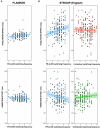Language athletes: Dual-language code-switchers exhibit inhibitory control advantages
- PMID: 37063556
- PMCID: PMC10102468
- DOI: 10.3389/fpsyg.2023.1150159
Language athletes: Dual-language code-switchers exhibit inhibitory control advantages
Abstract
Recent studies have begun to examine bilingual cognition from more nuanced, experienced-based perspectives. The present study adds to this body of work by investigating the potential impact of code-switching on bilinguals' inhibitory control abilities. Crucially, our bilingual participants originated from a predominantly dual-language environment, the interactional context which is believed to require (and therefore, potentially train) cognitive control processes related to goal-monitoring and inhibition. As such, 266 French Canadian bilinguals completed an online experiment wherein they were asked to complete a domain-general (Flanker) and a language-specific (bilingual Stroop) inhibitory control task, as well as extensive demographic and language background questionnaires. Stepwise multiple regressions (including various potential demographic and linguistic predictors) were conducted on the participants' Flanker and Stroop effects. The results indicated that the bilinguals' propensity to code-switch consistently yielded significant positive (but unidirectional) inhibitory control effects: dual-language bilinguals who reported more habitual French-to-English switching exhibited better goal-monitoring and inhibition abilities. For the language-specific task, the analysis also revealed that frequent unintentional code-switching may mitigate these inhibition skills. As such, the findings demonstrate that dual-language code-switchers may experience inhibitory control benefits, but only when their switching is self-reportedly deliberate. We conclude that the bilinguals' interactional context is thus of primary importance, as the dual-language context is more conducive to intentional code-switching. Overall, the current study highlights the importance of considering individualistic language experience when it comes to examining potential bilingual executive functioning advantages.
Keywords: adaptive control hypothesis; bilingualism; code-switching; executive function; inhibitory control; interactional context.
Copyright © 2023 Gosselin and Sabourin.
Conflict of interest statement
The authors declare that the research was conducted in the absence of any commercial or financial relationships that could be construed as a potential conflict of interest.
Figures




References
-
- Abutalebi J., Green D. W. (2008). Control mechanisms in bilingual language production: neural evidence from language switching studies. Lang. Cognit. Process. 23, 557–582. doi: 10.1080/01690960801920602 - DOI
-
- Adamou E., Shen X. R. (2019). There are no language switching costs when codeswitching is frequent. Int. J. Biling. 23, 53–70. doi: 10.1177/1367006917709094 - DOI
-
- Allaire G. (2007). From “nouvelle-France” to “Francophonie canadienne”: a historical survey. Int. J. Sociol. Lang. 2007, 25–52. doi: 10.1515/IJSL.2007.024 - DOI
-
- Alrwaita N., Houston-Price C., Pliatsikas C. (2022). The effects of using two variants of one language on cognition: Evidence from bidialectalism and diglossia. Linguist. Approaches Biling. doi: 10.1075/lab.21044.alr - DOI
LinkOut - more resources
Full Text Sources
Research Materials

